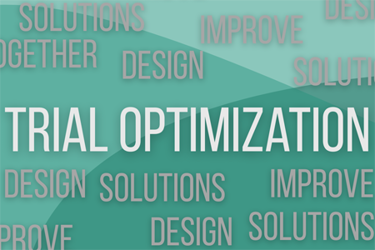Celebrating Clinical Trials Day, Part 2: Trial Optimization In Action
As told to Abby Proch, executive editor of guest columns, Clinical Leader

Everyone likes a good tip on how to run their trials better, right? To mark Clinical Trials Day 2025, and in the second part of this series celebrating the industry we know and love (you know you do), a handful of leaders throughout biotech and pharma are dishing. Here, they share stumbling blocks, missteps, and tough decisions that have required them to rethink their efforts. Here’s hoping their challenging times make easier times for you.
Hans Warrinnier, Chief Medical Officer, Bioxodes
 “At the start of our clinical trial with BIOX-101, we ran into a problem that had to do with the lack of therapeutic development for hemorrhagic stroke. A fair number of clinical trials have been done into ischemic stroke, but far fewer into hemorrhagic stroke. As a result, and based on ischemic stroke experiences, the maximum allowed interval between the first symptoms and first treatment was 12 hours. This turned out to be a challenge for the stroke centers.
“At the start of our clinical trial with BIOX-101, we ran into a problem that had to do with the lack of therapeutic development for hemorrhagic stroke. A fair number of clinical trials have been done into ischemic stroke, but far fewer into hemorrhagic stroke. As a result, and based on ischemic stroke experiences, the maximum allowed interval between the first symptoms and first treatment was 12 hours. This turned out to be a challenge for the stroke centers.
This is because while ischemic stroke is a disease with acute symptoms, hemorrhagic stroke often starts more gradually. Patients tend to come into the hospital later, and sometimes, there wasn’t enough time to register them for the trial. So, we amended the protocol and changed the maximum intake time to 24 hours, still in line with the biology of the disease. It was an unforeseen challenge, but we could explain well why we wanted the change in protocol. The regulator approved quickly, and trial recruitment has now become much less problematic.”
 Norman Sussman, MD, FAASLD, Chief Medical Officer, DURECT
Norman Sussman, MD, FAASLD, Chief Medical Officer, DURECT
"DURECT is developing a drug to treat alcohol-associated hepatitis (AH), a life-threatening disease with no approved medical therapy. We are preparing to initiate a pivotal Phase 3 trial, which will use ‘mortality at 90 days’ as the primary endpoint instead of ‘mortality or liver transplantation (LT) at 90 days,’ based on insights from our completed global Phase 2b trial (AHFIRM).
LT has become an accepted treatment for AH, but it is resource-intensive and available to only a tiny fraction of AH patients. Since AH studies are frequently done in specialized centers, LT is greatly overrepresented in recent studies compared to the entire AH population. Not every patient who gets LT would die without it, but we have no way of determining this once LT is done. Therefore, accounting for LT in AH studies is a vexing issue for companies, researchers, and regulatory agencies.
To create a road map for future AH studies, including our Phase 3, we assembled a group of experts in hepatology, statistics, and drug development and reviewed design options based on our AHFIRM trial. This review showed that analyses of overall survival, principal stratum, and competing risk were nearly equally efficient, but that combining LT and death as an endpoint was inefficient, and might bias a study against an effective drug. The details of the review have been accepted for publication in Hepatology Communications."
 Prof. David Hunter, MBBS Hons, MSc Clin Epi, M SpMed, Ph.D., FRACP Rheum, Florance and Cope Chair of Rheumatology, Co-Director Sydney Musculoskeletal Health Flagship, University of Sydney
Prof. David Hunter, MBBS Hons, MSc Clin Epi, M SpMed, Ph.D., FRACP Rheum, Florance and Cope Chair of Rheumatology, Co-Director Sydney Musculoskeletal Health Flagship, University of Sydney
"One crucial challenge in drug development is addressing the placebo response. We tackled this by employing a covariate adjustment approach, called Placebell, that helped us to mitigate the wide impact of placebo response. After a first collaboration, we have decided this approach will become a critical part of our strategy to improve effect size estimation by reducing the interference of the placebo response — ultimately enhancing the reliability of trial outcomes and contributing to more effective treatments. For example, in a clinical trial on hand osteoarthritis, [the tool] identified a bias in the distribution of groups, highlighting the importance of statistical adjustments to ensure accurate results."
 Philippe Legenne, MD, MBA, Chief Medical Officer, Molecular Partners
Philippe Legenne, MD, MBA, Chief Medical Officer, Molecular Partners
“During a Phase 1/2a clinical trial of MP0533, our multispecific T cell engager for patients with relapsed/refractory acute myeloid leukemia (AML) or myelodysplastic syndrome/AML, we saw a lower-than-expected efficacy and no clear dose response in the first seven cohorts. While initial blast reductions were encouraging, they did not translate into the number of responders one might want to see. On review of the data, it became apparent we were not dosing patients with enough drug, early enough, to impact such a rapidly progressing disease. Given encouraging signs of initial activity and the strong feedback from KOLs, we felt compelled to keep trying.
The challenge was to find a way to optimize the dosing scheme, which we thought would lead to improved response rates and depth. By introducing an additional dosing timepoint at day 12, we were able to reach the target dose faster in cohort 8 and expose patients to more drug earlier. Initial data indicate increased rates and depth of responses, with three out of eight evaluable patients demonstrating responses to date.
The protocol is being amended and submitted to regulatory authorities to improve the exposure profile based on the learnings from the dose escalation. This foresees further dose densification and premedication to mitigate loss of exposure for the next cohorts to replicate response rates observed in cohort 8 but, importantly, to further deepen responses and increase the duration of responses.”
 Paula Buckley, VP, Clinical Operations, Trevi Therapeutics
Paula Buckley, VP, Clinical Operations, Trevi Therapeutics
“We encountered slow recruitment while running a Phase 2a study. The plan to remedy the situation was to identify new sites that had success activating quickly and recruiting patients in this condition. This needed to be done while managing start-up costs and tight timelines.
Due to CRO resource constraints, our team functioned outside of the normal process using our own SOPs to conduct pre-study visits to confirm that these sites were compliant and could help achieve our recruitment goals. Essentially, we assisted our CRO in bringing on sites that we chose and performed all start-up activities and then facilitated the integration of the CRO to complete the SIV and final site activation. This agility enabled us to expedite the study start-up process with activation in two months, versus the standard six-month duration.
To further drive efficiency, we maintained consistent touchpoints with sites, which enabled us to meet recruitment timelines. For the current Phase 2b idiopathic pulmonary fibrosis (IPF) trial in patients with chronic cough and the refractory chronic cough studies, many of these same principles were applied to achieve faster site activation timelines, thus bolstering recruitment.”
 Nadia K. Waheed, MD, MPH, Chief Medical Officer, Ocular Therapeutix
Nadia K. Waheed, MD, MPH, Chief Medical Officer, Ocular Therapeutix
"A challenge I overcame as a clinical research professional involved managing differing regulatory requirements for clinical trial endpoints set by the FDA and European agencies during a global study for retinitis pigmentosa.
European regulators require a magnitude of change on mean microperimetry — a measure of overall retinal sensitivity — as a primary endpoint. However, the FDA requires improvement of at least 7 decibels at five pre-specified points on the microperimetric grid. This presented a significant challenge with trial design, as the endpoints differed and evaluated distinct aspects of visual function. Additionally, it’s difficult to predict which points on the microperimetric grid will demonstrate improvement.
We implemented a dual-endpoint strategy: using mean microperimetry for Europe and best corrected visual acuity (BCVA) and the maze navigation test for the FDA. This required complex statistical modeling, regional stratification, and adaptive recruitment strategies to ensure the trial remained powered across both regions.
This approach ensured successful regulatory submissions across both regions, enabling broader global applicability of the data, while providing a model for future trials navigating global regulatory expectations in rare retina conditions."
 Derek Wallace, President, Vaccine Business Unit, Takeda
Derek Wallace, President, Vaccine Business Unit, Takeda
“Much of my career has focused on developing solutions for dengue, a complex disease with four unique and constantly shifting strains. Mitigating these variables required a comprehensive clinical trial design, large and diverse enough to collect data during multiple outbreaks, across all strains, in people with or without prior dengue exposure, and over a lengthy period of time.
Takeda met this challenge with the Phase 3 TIDES trial evaluating our dengue vaccine — our largest interventional study by the company to date. TIDES enrolled over 20,000 children and adolescents across 26 sites in eight dengue-endemic countries in Latin American and Asia. This scale enabled us to gather robust data, with 130,000 blood samples and 160,000 clinic visits.
We continue to invest in research to understand real-world vaccine impact, particularly in regions hardest hit by dengue. This includes the recently initiated DEN-401 trial, an observational study assessing our dengue vaccine’s real-world effectiveness in preventing dengue-related hospitalizations among young people in Southeast Asia. The DEN-401 study underscores our commitment to vaccine accessibility and global efforts to reduce dengue’s burden.
Through ongoing evidence generation, we provide reliable efficacy and safety data to help stakeholders make informed decisions and better protect communities worldwide.”
 Thomas Langenickel, MD, Ph.D., Chief Medical Officer, Ethris
Thomas Langenickel, MD, Ph.D., Chief Medical Officer, Ethris
“At Ethris, our mission is to develop novel treatments for pulmonary diseases, such as the prevention of virus-induced exacerbations in asthma and mucosal vaccines, using an inhaled and nasal mRNA-based approach. Through our work, we quickly recognized the need for a formulation that enables targeted delivery and expression of the selected mRNA-coded protein in the respiratory tract. Nasal and pulmonary delivery of mRNA formulations have historically been challenging due to difficulties in achieving successful mucosal penetration and confirmed local retention.
To enhance clinical success, we developed a proprietary lipioid formulation capable of penetrating the mucus layer, a breakthrough confirmed by readouts from our first clinical trial. Another critical factor in optimizing drug efficacy is ensuring that aerosolized formulations maintain the integrity and quality of the lipidoid nanoparticles.
Before initiating our first trial, we tested different devices and technologies to identify the most suitable option for aerosolizing our lipid nanoparticle formulations — an insight that will guide conduct of future trials. For our upcoming Phase 2a asthma trial, our research demonstrated that we could achieve an optimal therapeutic response using a nasal spray, and therefore optimized a sampling protocol for nasal lining fluid to collect the best possible samples for key trial endpoints.”
 Joel Raskin, MD, Chief Medical Officer, Arrivo BioVentures
Joel Raskin, MD, Chief Medical Officer, Arrivo BioVentures
"A common issue in clinical trials is trying to understand an unexpected result or post-hoc finding. Is it a true positive? Digging into the literature can provide some direction, as can preclinical cell, genomic, and animal studies to elucidate the biology and support the hypothesis. Smaller clinical studies can confirm a biologically active dose and measure activity.
In our recent Phase 2 antidepressant study at Arrivo, we were surprised to see a consistent benefit in females compared to males with forvisirvat, a novel epigenetic SIRT6 activator. To determine if this was a true finding, despite numerous data cuts supporting the finding, we needed more evidence to move forward. Previous mouse and human studies have shown males and females with depression have many genes that move in opposite directions, so an epigenetic drug could have differential effects by sex. To confirm, we quickly conducted cell and animal studies in depression models that showed a differential sex effect with forvisirvat on gene expression, proteomics, and behavior. A qEEG study confirmed a biologically active dose with procognitive and antidepressant effects. These findings supported our hypothesis, and we are now evaluating forvisirvat’s potential benefit for females with major depression in a Phase 2b/3 study."
 Katherine Ruffner, Executive Director, Clinical Development, Orano Med
Katherine Ruffner, Executive Director, Clinical Development, Orano Med
"One of the biggest challenges for any drug development program is obtaining timely and close engagement from the FDA for feedback on clinical trial design and conduct. Breakthrough Therapy designation is a very effective tool both for gauging the FDA’s interest in the drug’s potential benefits to patients and for enabling frequent interactions with the regulatory agency throughout clinical development. Obtaining Breakthrough Therapy designation requires compelling preliminary data that demonstrates substantial improvements over currently approved therapies in serious or life-threatening diseases. It also requires maintaining close attention to exchanges with the FDA, actively gathering feedback, and aligning expectations to help anticipate regulatory requirements. Given that only a minority of applications receive this designation, a well-prepared approach is essential.
Breakthrough Therapy designation for 212Pb-DOTAMTATE was granted by the FDA in February 2024, which is a tribute both to the development team’s ingenuity as well as to the strength of the data reported to date from our clinical trials. I am proud and honored to be a part of the team that obtained Breakthrough Therapy designation and paved the way for accelerated development of 212Pb-DOTAMTATE in the treatment of GEP-NETs, in our mission to make this potential new treatment option available for patients in need."
Interested in what clinical research experts had to say about their experiences in other areas? Check out Part 1: Putting The Patient First and Part 3: Making The Most Of Resources.
